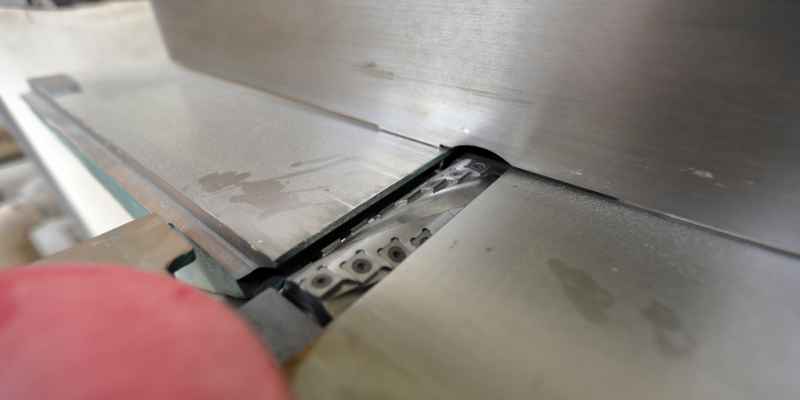Jointers are used to create flat surfaces and straight edges on wood boards. They are essential tools for woodworking projects.
Woodworking enthusiasts and professionals often rely on jointers to achieve precise and accurate results. Jointers work by shaving off small amounts of wood from the edges or faces of boards, allowing them to fit together seamlessly. This not only helps in creating smooth and even surfaces but also ensures stability and proper alignment when joining multiple pieces of wood.
From making furniture pieces to building cabinets and shelves, jointers are indispensable tools for achieving professional-level woodworking craftsmanship. With the ability to refine and flatten wood surfaces effectively, jointers are a must-have for anyone passionate about woodworking.
The Role Of Jointers
Jointers are indispensable tools used in woodworking to create flat and smooth surfaces on rough lumber. They are essential for achieving precise and accurate joinery, ensuring seamless and professional-looking finished products.
Smooth And Straighten Boards
A jointer plays a crucial role in woodworking by enabling you to smooth and straighten boards effortlessly. It is designed to flatten the surface of rough lumber and create smooth, even edges.
With a jointer, you can easily eliminate any twists, warps, or irregularities in the wood, ensuring that the boards are perfectly straight and level. By using the jointer correctly, woodworkers can produce high-quality furniture and other wooden items.
Create Perfectly Flat Surfaces
A jointer is a remarkable tool for creating perfectly flat surfaces on various woodworking projects. Whether you are building a table, installing flooring, or crafting cabinets, achieving a level and flat surface is crucial for a professional finish.
By feeding the wood stock through the jointer’s cutterhead, any bumps or unevenness on the surface are removed, resulting in a flat and smooth board. This allows for better gluing and helps prevent any gaps or imperfections in the final product.
Maintain Jointers For Optimal Performance
To ensure your jointer performs at its best, regular maintenance is essential. Here are some tips to keep your jointer in optimal condition:
- Clean the jointer after each use by removing any debris or residue that may accumulate.
- Regularly inspect the cutting blades and rotate or replace them when necessary to maintain sharpness.
- Check the fence alignment to ensure it is square to the table, guaranteeing accurate and straight cuts.
- Lubricate movable parts periodically to prevent rust and ensure smooth operation.
| Pros | Cons |
|---|---|
| Allows for precise smoothing and straightening of boards. | Can be a noisy and potentially dangerous tool if used improperly. |
| Creates flat surfaces, ideal for seamless joinery and gluing. | Requires initial investment and space in the workshop. |
| Enhances the overall quality of woodworking projects. | May be challenging for beginners to master the correct techniques. |
By understanding the role of jointers in woodworking, you can appreciate the value they bring to your projects. Whether you need to smooth rough lumber, straighten boards, or create perfectly flat surfaces, a jointer is an indispensable tool in any woodworker’s arsenal.

Different Types Of Jointers
When it comes to woodworking, jointers are essential tools that help create smooth and seamless edges on wooden boards. By removing imperfections and ensuring a flat surface, jointers play a crucial role in achieving precise and professional results. There are different types of jointers available in the market, each with its own set of features and benefits. In this section, we will explore the two main types of jointers: Benchtop Jointers and Stationary Jointers.
Benchtop Jointers
A benchtop jointer, as the name suggests, is a compact and portable tool that can be easily placed on top of a workbench. It is perfect for small woodworking projects or hobbyists who have limited space. Despite their smaller size, benchtop jointers are capable of producing accurate and smooth cuts, making them an excellent choice for beginners and DIY enthusiasts.
These jointers typically have a cutting width ranging from 6 to 8 inches, which is suitable for most woodworking tasks. They are equipped with a fence that allows you to adjust the angle of the cut and ensures precise alignment.
Stationary Jointers
A stationary jointer is a larger and more powerful machine designed for professional woodworkers or those working on larger projects. Unlike benchtop jointers, stationary jointers are fixed to the ground or a sturdy workbench.
These jointers usually have a wider cutting width, ranging from 8 to 16 inches, allowing you to work with bigger and thicker pieces of wood. Stationary jointers come with a longer and heavier infeed and outfeed table, ensuring better stability and support for larger boards.
They also feature a more robust motor, enabling them to handle hardwoods and tougher materials with ease. Stationary jointers are ideal for professional workshops or craft businesses, where accuracy and efficiency are paramount.
Whether you opt for a benchtop jointer or a stationary jointer, each type has its own advantages based on your specific needs and requirements. Consider the size and scope of your projects, available workspace, and budget before making a decision. Both types of jointers can help you achieve the smooth and seamless edges you desire, making your woodworking projects a true work of art.
Tips For Using A Jointer
A jointer is a versatile woodworking tool used primarily to flatten and smooth the faces of boards and create a perfectly straight edge along one side. It is an essential tool in any woodworking shop and is commonly used in furniture making, cabinetry, and general woodworking projects. Jointers are particularly valuable for preparing boards for gluing, as they ensure a tight and seamless joint. With a jointer, you can achieve professional-level precision in your woodworking projects.
Safety Precautions
Before using a jointer, it is crucial to adhere to proper safety precautions to protect yourself and maintain a safe working environment. Follow these safety guidelines:
- Always wear protective gear, including safety glasses or goggles, ear protection, and appropriate clothing.
- Ensure the jointer is placed on a sturdy and stable surface to prevent any movement during operation.
- Keep your hands and fingers at a safe distance from the cutterhead at all times. Use push blocks or push pads to guide the board through the jointer.
- Do not stand directly behind the board. Position yourself to the side to avoid any kickback.
- Keep the jointer’s cutting area clear of debris and small wood scraps.
- Disconnect the power source before making any adjustments or changes to the jointer.
Setting Up The Machine
Properly setting up your jointer is crucial to ensure accurate and effective operation. Follow these tips to set up your jointer correctly:
- Check that the jointer’s blades are sharp and properly aligned. Dull or misaligned blades can result in poor cutting performance and potential safety hazards.
- Adjust the cutterhead height to remove just the right amount of material from the board. It’s essential to find the right balance between removing imperfections and preserving the board’s thickness.
- Set the fence position to create a straight edge along the board’s side. Use a straightedge or a jointer jig to verify the accuracy of the fence.
- Ensure the infeed and outfeed tables are perfectly aligned with the cutterhead. This alignment guarantees a consistent and smooth board feed through the jointer.
Techniques For Optimal Results
To achieve optimal results when using a jointer, practice these techniques:
- Feed the board against the cutterhead with a steady and consistent motion, avoiding sudden stops or hesitations.
- Apply downward pressure on the board as you push it through the jointer to keep it flat and firmly against the table.
- Use a jointer jig or featherboards to ensure a straight cut and prevent the board from wandering or tilting.
- Make multiple passes with shallow cuts rather than attempting to remove too much material in a single pass. Gradual cutting reduces strain on the machine and produces smoother results.
- Inspect the board regularly during the jointing process to ensure flatness and edge straightness.

Frequently Asked Questions For What Are Jointers Used For
What Is One Purpose Of The Jointer?
A jointer is used to create flat surfaces and edges on lumber for woodworking projects.
What Is The Most Common Use For A Jointer?
A jointer is commonly used in woodworking to create flat and even surfaces on lumber. It helps in achieving smooth edges and creating precise angles for joining pieces of wood together.
When Should You Use A Jointer?
A jointer is used when you need to straighten and flatten the edges of rough lumber or boards. It is helpful in woodworking projects to ensure smooth and even joints for better alignment and glue-ups.
What Is A Jointer In Woodworking?
A jointer in woodworking is a tool used to flatten, straighten, and square wood surfaces. It is essential for creating smooth and even boards for various woodworking projects.
Conclusion
After reading this blog post, it is clear that jointers play a crucial role in woodworking projects. They are essential for ensuring flat and smooth surfaces, making them a valuable tool for both professionals and hobbyists. By providing precision and accuracy in cutting, jointers enable the creation of high-quality joints for strong and durable woodworking pieces.
Incorporating a jointer into your workshop can greatly enhance the overall quality of your projects.


